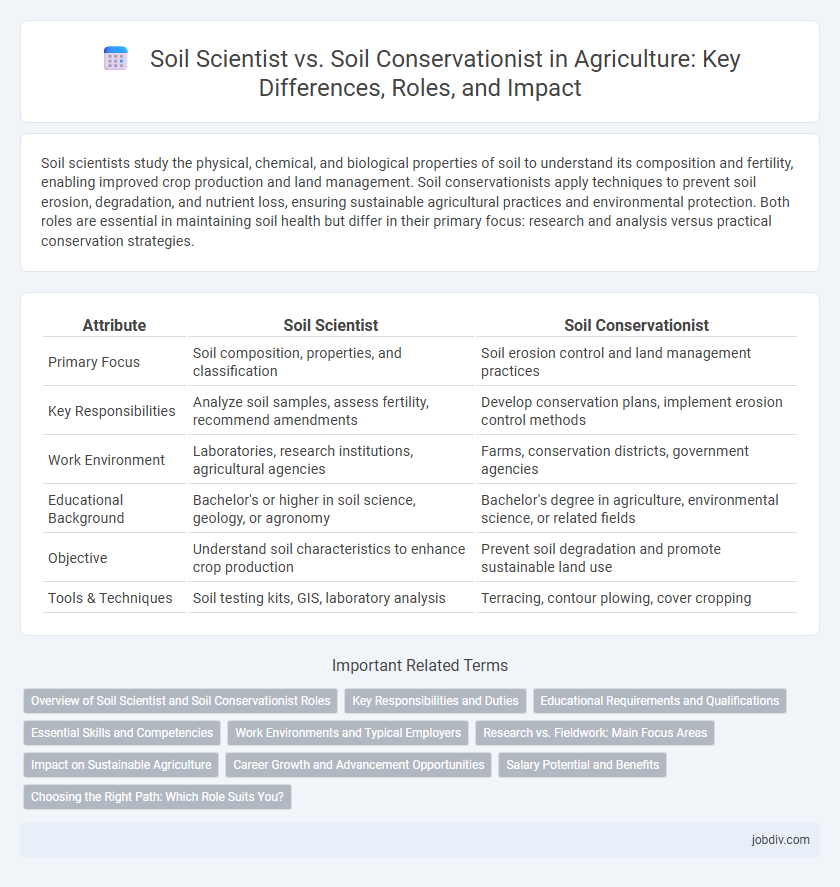Soil scientists study the physical, chemical, and biological properties of soil to understand its composition and fertility, enabling improved crop production and land management. Soil conservationists apply techniques to prevent soil erosion, degradation, and nutrient loss, ensuring sustainable agricultural practices and environmental protection. Both roles are essential in maintaining soil health but differ in their primary focus: research and analysis versus practical conservation strategies.
Table of Comparison
| Attribute | Soil Scientist | Soil Conservationist |
|---|---|---|
| Primary Focus | Soil composition, properties, and classification | Soil erosion control and land management practices |
| Key Responsibilities | Analyze soil samples, assess fertility, recommend amendments | Develop conservation plans, implement erosion control methods |
| Work Environment | Laboratories, research institutions, agricultural agencies | Farms, conservation districts, government agencies |
| Educational Background | Bachelor's or higher in soil science, geology, or agronomy | Bachelor's degree in agriculture, environmental science, or related fields |
| Objective | Understand soil characteristics to enhance crop production | Prevent soil degradation and promote sustainable land use |
| Tools & Techniques | Soil testing kits, GIS, laboratory analysis | Terracing, contour plowing, cover cropping |
Overview of Soil Scientist and Soil Conservationist Roles
Soil scientists analyze soil properties, composition, and structure to guide effective land use, crop production, and environmental protection, often conducting field surveys and laboratory tests. Soil conservationists focus on implementing practices that prevent soil erosion and degradation, promoting sustainable land management and water quality preservation. Both roles collaborate to support agricultural productivity and natural resource conservation through scientific research and practical application.
Key Responsibilities and Duties
Soil Scientists analyze soil characteristics, composition, and fertility to guide land management and agricultural productivity. Soil Conservationists focus on developing and implementing practices to prevent soil erosion, improve soil health, and promote sustainable land use. Both professionals collaborate with farmers, environmental agencies, and policymakers to optimize soil resources and ensure long-term agricultural sustainability.
Educational Requirements and Qualifications
Soil scientists typically require a bachelor's degree in soil science, agronomy, environmental science, or a related field, often complemented by a master's degree for advanced research roles. Soil conservationists generally hold degrees in soil conservation, environmental science, natural resource management, or agricultural engineering, with certifications in conservation planning enhancing qualifications. Both professions benefit from knowledge in soil chemistry, geology, and environmental regulations, but soil scientists emphasize analytical skills while soil conservationists focus on practical land management techniques.
Essential Skills and Competencies
Soil scientists require strong analytical skills, proficiency in soil sampling and laboratory analysis, and expertise in interpreting soil properties to support agricultural productivity. Soil conservationists excel in environmental planning, resource management, and implementation of sustainable land use practices to prevent erosion and degradation. Both roles demand knowledge of soil chemistry, biology, and ecology, but soil conservationists emphasize practical application and community engagement skills for effective conservation strategies.
Work Environments and Typical Employers
Soil scientists primarily work in research institutes, agricultural companies, and government agencies focused on soil analysis and land management, conducting field studies and laboratory testing. Soil conservationists are often employed by environmental organizations, federal conservation programs like the USDA Natural Resources Conservation Service, and land management firms, focusing on preventing soil erosion and promoting sustainable land use practices. Both professionals frequently collaborate with farms, universities, and environmental consultancies to support soil health and agricultural productivity.
Research vs. Fieldwork: Main Focus Areas
Soil scientists primarily concentrate on laboratory research and data analysis to understand soil properties, composition, and processes, driving innovations in soil management and fertility. Soil conservationists emphasize fieldwork, implementing practical strategies to prevent soil erosion and degradation, working directly with farmers and landowners to promote sustainable land use. Both roles collaborate to enhance soil health, balancing scientific research with hands-on conservation practices to support agricultural productivity.
Impact on Sustainable Agriculture
Soil scientists analyze soil properties and processes to improve soil health and productivity, directly enhancing crop yields and sustainable land use. Soil conservationists implement practical measures such as erosion control, nutrient management, and land restoration to prevent soil degradation and maintain ecosystem balance. Both roles are crucial for sustainable agriculture by ensuring long-term soil fertility and minimizing environmental impact.
Career Growth and Advancement Opportunities
Soil scientists often experience career growth through research positions, academic roles, and consulting opportunities that emphasize soil analysis and environmental impact assessments. Soil conservationists advance by engaging in fieldwork and policy development, focusing on sustainable land management practices and erosion control projects. Both careers offer progression through specialization and leadership roles in agricultural agencies, environmental organizations, and government programs.
Salary Potential and Benefits
Soil scientists typically earn an average annual salary ranging from $60,000 to $90,000, benefiting from opportunities in research, environmental consulting, and government agencies. Soil conservationists often receive competitive salaries between $55,000 and $85,000, with added benefits such as fieldwork experience, community engagement, and roles in sustainable land management programs. Both professions offer potential for growth, but soil scientists may have higher earning potential due to specialized expertise in soil chemistry and analysis.
Choosing the Right Path: Which Role Suits You?
Soil scientists analyze soil properties and composition to support agricultural productivity and environmental health, focusing on research, testing, and data interpretation. Soil conservationists apply practical strategies to prevent erosion, improve soil management, and promote sustainable land use, often working directly with farmers and communities. Consider your interest in scientific research versus hands-on conservation efforts to determine whether a career as a soil scientist or soil conservationist aligns best with your skills and goals.
Soil Scientist vs Soil Conservationist Infographic

 jobdiv.com
jobdiv.com